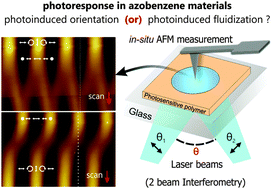A comparative study of photoinduced deformation in azobenzene containing polymer films†
Abstract
In this paper two groups supporting different views on the mechanism of light induced polymer deformation argue about the respective underlying theoretical conceptions, in order to bring this interesting debate to the attention of the scientific community. The group of Prof. Nicolae Hurduc supports the model claiming that the cyclic isomerization of azobenzenes may cause an athermal transition of the glassy azobenzene containing polymer into a fluid state, the so-called photo-fluidization concept. This concept is quite convenient for an intuitive understanding of the deformation process as an anisotropic flow of the polymer material. The group of Prof. Svetlana Santer supports the re-orientational model where the mass-transport of the polymer material accomplished during polymer deformation is stated to be generated by the light-induced re-orientation of the azobenzene side chains and as a consequence of the polymer backbone that in turn results in local mechanical stress, which is enough to irreversibly deform an azobenzene containing material even in the glassy state. For the debate we chose three polymers differing in the glass transition temperature, 32 °C, 87 °C and 95 °C, representing extreme cases of flexible and rigid materials. Polymer film deformation occurring during irradiation with different interference patterns is recorded using a homemade set-up combining an optical part for the generation of interference patterns and an atomic force microscope for acquiring the kinetics of film deformation. We also demonstrated the unique behaviour of azobenzene containing polymeric films to switch the topography in situ and reversibly by changing the irradiation conditions. We discuss the results of reversible deformation of three polymers induced by irradiation with intensity (IIP) and polarization (PIP) interference patterns, and the light of homogeneous intensity in terms of two approaches: the re-orientational and the photo-fluidization concepts. Both agree in that the formation of opto-mechanically induced stresses is a necessary prerequisite for the process of deformation. Using this argument, the deformation process can be characterized either as a flow or mass transport.


 Please wait while we load your content...
Please wait while we load your content...